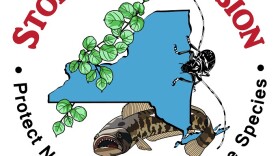Scientists studying Lake Champlain have confirmed that a new invasive species has entered the lake — and the population has surged since its first detection.
The Fishhook Waterflea was first detected in Lake Champlain last September by scientists at SUNY Plattsburgh’s Lake Champlain Research Institute. Dr. Tim Mihuc says they monitor 14 sites. “They’re called the fishhook because there’s a hook or like a crook in their spine at the end and that little hook gets caught on everything. So it’ll get caught on any line that’s in the water. Fishermen have already begun to report just massive amounts of these. They look like cotton when you pull them up out of the water. There’s just globs of these Fishhook Waterflea on fishing lines. Lots of people will find it to be very disconcerting when you pull up your fishing line and there’s all this stuff on it that’s a living organism. So they’re going to be a very public nuisance.”
Boat launch stewards for the Lake Champlain Basin Program reported that nearly all fishing boats returning to the Shelburne Bay and Converse Bay launches last week were infested with the Fishhook Waterflea. Captain Brian Dunkling owns Sure Strike Charters in Shelburne, Vermont. He says after trolling for 15 minutes he has to pull up lines because they are already clogged. “It’s really miserable. Basically you start reeling your line in and at some point you get enough of it balled up on the tip of your rod where you can’t reel no more and if you tighten your drag up to keep reeling you either break the tip of your pole or break your line. So you pretty much you gotta stop pull them all off and then start reeling again. When it plugs up you start all over again. It’s like a big ball of snot, that’s what it looks like, down your line and it’ll be as big around as your thumb.”
Since the Fishhook Waterflea was detected in samples last fall the number has exploded. Again Tim Mihuc: “This species puts out what’s called a resting egg. So that egg goes and lies on the sediment over winter. And we knew from the data from last fall that there were millions of resting eggs in the lake over winter and it was just a matter of when would they emerge and when would those populations expand.”
Lake Champlain Committee Executive Director Lori Fisher notes that part of the profile of an aquatic invasive is the ability to quickly spread. "Fishhook Waterfleas are these tiny crustaceans. They’re very aggressive predators of plankton and plankton are typically eaten by native species in the lake. They can really disrupt the lake’s food chain. In addition to the major ecological and ecosystem effects or the potential for that while they don’t have adverse affects on human health that we know about they really have significant recreational impacts. And then of course there’s a real concern about their spread by humans to other waterbodies.”
The incursion of the Fishhook Waterflea into the lake was confirmed by the Lake Champlain Basin Program. Director Dr. Eric Howe says the invasive zooplankton has been on a watch list for a while, having already infested the Great Lakes and other waterbodies. “The only thing that we can do now is really encourage folks to Clean, Drain and Dry their gear as much as possible when they pull their boats or their angling equipment out of Lake Champlain to reduce the risk of spreading the species to other waterbodies in the Lake Champlain region. And that’s really the biggest thing that we can do now at this point that Fishhook Waterflea is in Lake Champlain is prevent it from moving to another waterbody.”
The Fishhook Waterflea is native to Eurasia and is believed to have spread to the Great Lakes in the 1980’s in ballast water. The species is also in the Finger Lakes and Lake Ontario.







